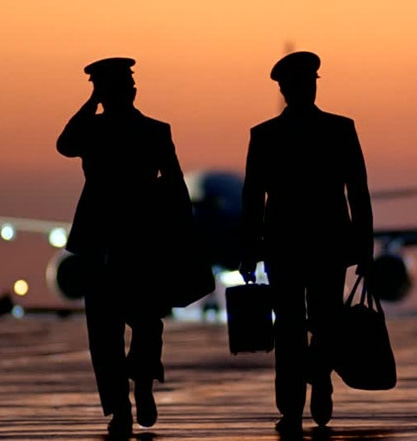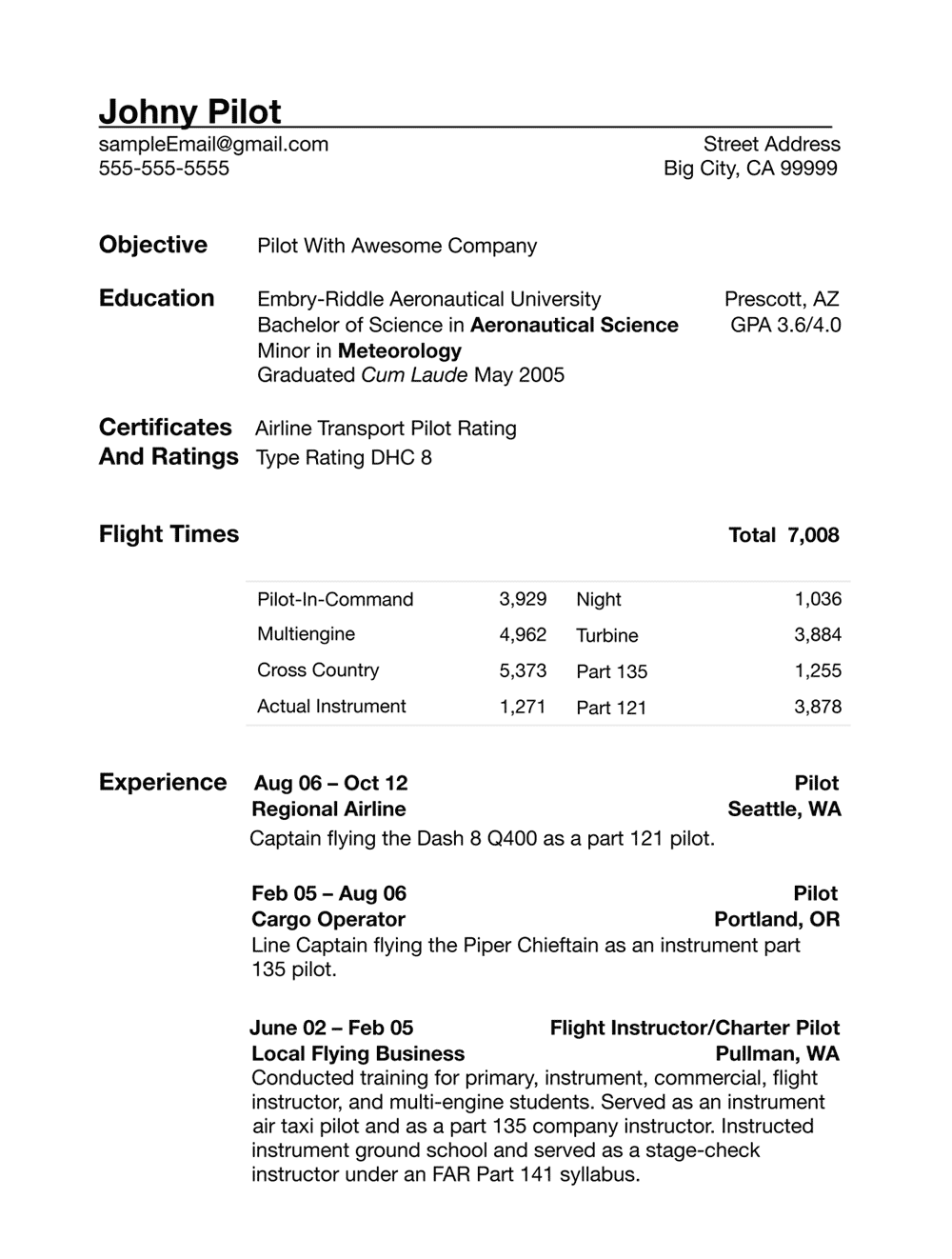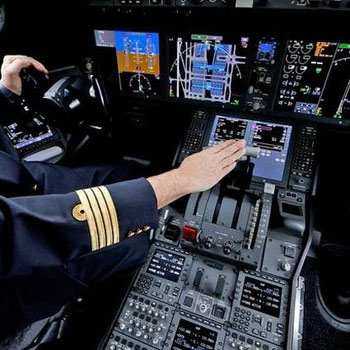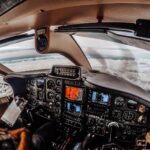Pilot Job Guide

Pilots are the driver’s seat in today’s market. But navigating the pilot career is still a daunting task. The following guide will help you plan out and navigate your career. This page is the hub of this guide, with more content branching out from it to help you become an expert for your career.
Pilot Job Market
The commercial aviation industry will need 637,000 new pilots from 2017 to 2036. This is according to a report from Boeing and it averages 87 new pilots needed each day. The demand is being driven from commercial operator growth, pilot retirements, and issues in the new-pilot supply pipeline.
10 Year Airline Pilot Job Outlook
Pilot Job Market by Region
Americas Region
Americas region includes United States, Canada, and emerging aviation markets in Central and South America as well as the Caribbean.
The United States is the world’s largest air travel market. The last 9 years in the United States have been been profitable due to low fuel prices, high yields and load factors, and industry consolidation. The profits are helping to fuel United States aviation growth.
Pockets of healthy aviation growth in Latin America will have positive effect on pilot demand.
European Region
Europe is expecting slower aviation growth due to geopolitical uncertainties as well as lower economic growth in some countries.The low cost carrier (LCC) business model is continuing to grow in Europe and pilot job locations are shifting to where the low cost carriers are based.
Most European countries hire new pilots directly from cadet training programs so don’t have pilot pipeline supply issues seen in other countries. However, the fast growth of the LCC airlines has caused them to pursue other recruiting options.
Middle Eastern Religion
The Middle East includes the Gulf region. Countries here have seen aggressive growth among their aviation employers. Middle eastern carriers have often staffed through hiring expatriate pilots. Middle eastern carriers have begun establishing training academies in an effort to build a local pool of pilots.
Some countries in Africa have seen steady economic growth and have been attempting to recruit pilots for their operations. These carriers can be a good opportunity for low-hour pilots seeking direct-entry into a range of airplane types.
Asia-Pacific Region
The Asia-Pacific region has the fastest growing commercial aviation sector in the world driven by a growing middle class. Demand for pilots in the Asia-Pacific region is not consistent crossed countries as some airlines are growing at a rapid pace while others are growing at a more sedate pace.
It is common for pilot employers in this region to hire experienced expat pilots as contractors. These pilots not only crew the operations but are also helping local pilots learn and develop. Aviation employers from this region are creating training programs in an attempt to build long-term programs to staff their operations from local pilots.
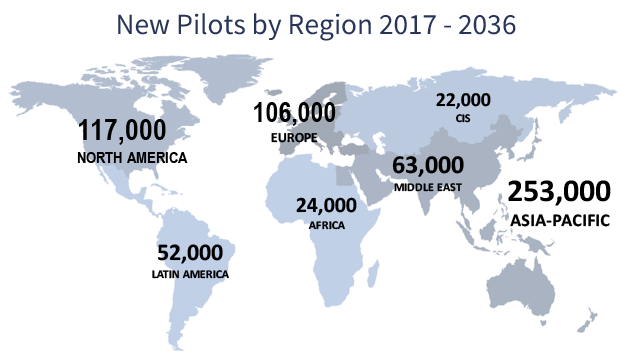
Pilot Hiring History
The aviation industry mirrors overall economic conditions though with higher peaks and lower valleys. There has been a few pronounced periods of increased pilot hiring with the first one taking place in the mid to late 1960s.
Every year from 1994 to 2000 was an all-time record year in pilot hiring. In recent history pilot hiring slowed due to economic recessions and the change in mandatory retirement age from 60 to 65.
In the United States regional and national airlines have been the most active in pilot hiring since 1997 though recent trends show this changing.
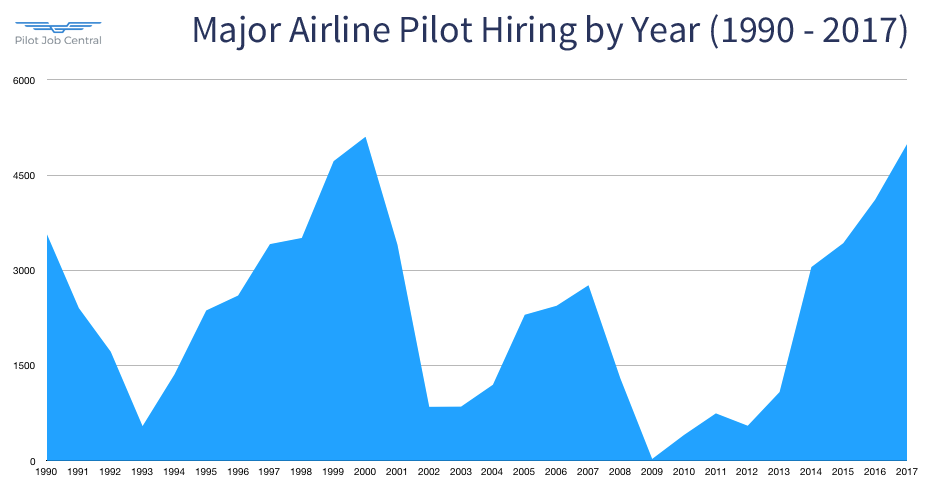
Factors That Drive Pilot Hiring
Economic Conditions and Fleet Growth
The commercial aviation industry amplifies the ups and downs of the overall economy. Hiring follows these patterns with pilots being hired at a furious pace during up-cycles and then pilots being furloughed during down-cycles.
We are now seeing a period where pilot hiring is being influenced by world economic conditions. That is, pilots are still in demand in other countries with growing aviation sectors even if there is a downturn in the United States.
Airline fleet planning occurs over long periods of time with new airplane orders being delivered many years after they are placed. Because of this, while pilot hiring booms and busts follow economic trends there is some smoothing from airplane fleet changes.
We are in a long-term period of increasing demand for commercial aviation. That is, more people across the globe now have the means to travel by air with. This global increase in demand is expected to continue and is so pronounced that the world wide fleet of airplanes in commercial service is expected to double in the next 20 years.
Regulations
The Airline Safety and Federal Aviation Administration Act of 2010 changed requirements for airlines so that all pilots flying for them must have an Airline Transport Pilot Rating (ATP). Regional airlines must now wait several years before they can hire new pilots that have entered the pilot supply pipeline.
The Airline Safety Act changed flight crew duty and rest requirements so that regional airlines had to increase staffing 5% to 8% to meet the new requirements.
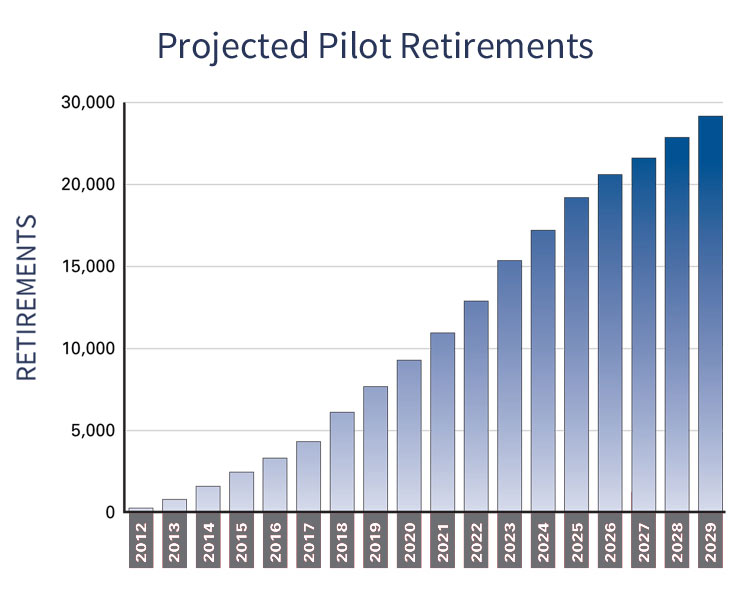
Mandatory Retirements
There is a bubble of mandatory retirements nearing. The FAA adjusted for this in 2009 by increasing mandatory retirement age from 60 to 65 years old. This only delayed the issue. It is anticipated that U.S. airlines will have to replace 30,000 retiring pilots by 2026.
Amount of Pilots Available to Work
There are fewer people entering the professional pilot pipeline. This has occurred for a few reasons:
- Training costs are too expensive to justify a reasonable return when entering into starting jobs that paid so little.
- Post 9/11 industry shakeup caused many pilots to lose their jobs and change careers. The reduced demand period turned potential candidates from entering the field.
- The Great Recession of 2007 to 2009 reduced consumer purchasing power and made it so fewer people were willing to undertake the significant cost of flight training. According to the FAA, new pilot certifications have not recovered to pre-recession levels.
- The impact of increasing retirement age had significant impact on the quality of the profession for younger pilots and many left due to career advancement stalling for a prolonged period.
Pilot Job Market Risk Factors
- Economic Recession. Historically recessions occur every 7 to 10 years. Furloughs can happen during downturns. Pilot employers will seek pay concessions during recessions with these typically being 5% to 15% pay cuts or the employers may seek deferrals on annual pay raises.
- Large company bankruptcy can temporarily flood the market with qualified pilots. One carrier’s demise is another operator’s gain, so there can end up being opportunity elsewhere.
- Company Mergers can cause pilots to lose seniority. In the short term period after a merger (3 to 6 months) there is a temporary decrease in hiring at the merged employer.
- Fuel Price increases can cause aircraft operators to reduce operations. This is more pronounced at operators that have older airplanes in their fleet.
- Low Cost Carriers and New Entrants into the market add volatility. New entrants are usually thinly capitalized and few survive, however, they cause downward pressure on air fares. Low cost carriers have grown to a large enough market share that they are restricting the Legacy carriers ability to pass on increased costs to consumers.
Pilot Job Market Trends
- Airline fleet composition is expected to change over the next decade with an increase in large narrowbody aircraft, such as the Airbus A321. Additionally, major carriers are bringing some flying perviously outsourced to regional airlines back in house, with an overall decrease to the fleet percentages for regional jets and turboprops.
- The cargo airplane fleet in the United States is expected to increase from 1,728 airplanes in 2012 to 3,198 airplanes by by 2031.
- Flow-through agreements from regional partners into major airlines is increasing. Most airlines have resisted forming such relationships but they are seen as a necessary incentive to attract pilots into flying for regional carriers. These type of agreements are more common when the major airline owns their regional parter(s).
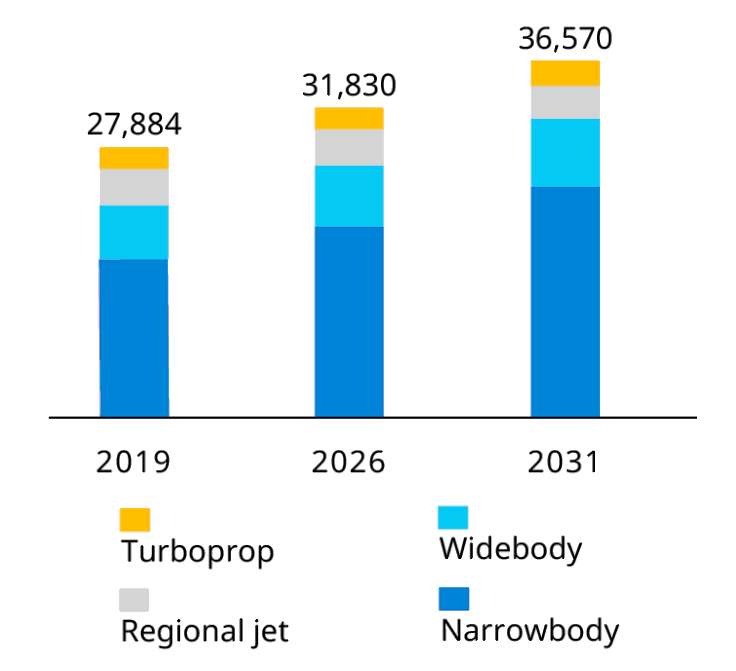
Planning Your Pilot Career Progression
A career as a pilot can be a long and challenging path but the rewards are worth it and stepping up the career ladder is manageable with planning and discipline.
Job Search Plan
Your pilot job search plan should include:
- Watching the market and interpreting the trends – the best time to change jobs is at the beginning of a hiring wave. You will accumulate seniority quicker and have less of a chance of being laid off if there’s a downturn. Make part of your career planning researching and keeping track of the job market and state of employers you want to work for.
- Setting personal timelines – set dates that you will complete additional pilot ratings and certificates. Determine general goals for when you will step up the career ladder and plan your job searches around this.
- Building a network – many pilot job opportunities are not about what you know but who you know. Particularly in a down market it will be important to have a professional network to help you find open positions and provide valuable recommendations.
- Staying fit – maintaining your health is important to renewing your medical certificate. Figure out an exercise program that you can stick with.
- Setting realistic goals that are commensurate with your experience level – most pilots want to start off their career flying a wide body airplane, but this isn’t going to happen. Know the minimum and competitive experience and qualifications required for each run of the pilot career ladder.
- Allowing time to build your flight experience and complete formal education – as a flight instructor you will average 300 to 600 hours of flight time a year. Most professional pilot jobs after that point accumulate around 800 hours of flight time each year. You can fly more than this, but planning around these guidelines is realistic. Be aware that some jobs accumulate less than the average, particularly in part part 135 cargo or corporate flying.
- Determine companies that you would like to work for as well as backup plans – know your dream job. But know that there might be better options for quality of life or pay once you get to that point. Have a goal in mind but be flexible might result in a better qualify of life.
- Coordinating with your family and getting and keeping them involved with plans – the hardships associated with being a professional pilot are shared by their close family. It is important to speak with them early and often about these. It will be easier to achieve your goals with your family staying behind you at each step.
- Reviewing your financial health and planning for points of lower pay as you move up in the career – as you move up in your pilot career, most positions will have probationary pay scales. It is important that you set up your finances so that you can take these year long pay cuts. Otherwise you may get the golden-handcuffs along the way and not have the option of moving up the pilot career ladder.
- Planning 6 months to a year worth of job search activities for each job change – changing jobs is difficult. Even when pilots are in demand the process can take a while. In your career planning make sure to account for the time needed to change jobs.
Pilot Job Search Sources
Employer Website
Most pilot employers will have at least one page on their website advising of job openings and how to apply to open positions.
Pro: most up to date for each employer
Cons: a great deal of work necessary to track open positions. Does not provide a complete picture of the job market.
Pilot Jobs Board
There are traditional style online jobs boards for pilots.
Pro: gives a wider picture of available openings.
Cons: online jobs boards charge pilots for access. Some jobs boards put up fake listings to make themselves look better.
Pilot Recruiting Agencies
Traditional employment recruiting agencies seek out pilots for their clients.
Pro: less work for pilots on their job search. You have a personal advocate helping with your job search.
Cons: agencies are less concerned about finding pilots the best fit or best compensation and are more concerned about helping their clients (employers).
Pilot Staffing Agencies
Provide temporary staffing solutions for pilot employers. They pay the pilots and then contract the pilot labor to the operator.
Pro: less work for pilots on their job search. Work can be high paying.
Cons: pilot positions are temporary. Most of these positions are overseas in developing countries.
Your Qualifications and Job Options
All employers have minimum hiring criteria for pilots. These minimums provide the employer with a way to pre-screen applicants. You will need to meet these minimums to be considered. To avoid showing discrimination, companies are careful to stick to requiring these minimums. These minimums are reevaluated and can change.
When choosing from applicants, employers will determine the average qualifications of pilots that have applied to them and will then evaluate applicants based on these averages. This is known as competitive minimums. When evaluating based on competitive criterion, employers won’t usually rule out a pilot for not meeting any single item but will evaluate that pilot as a whole.
Some factors considered for competitive qualifications include:
- Hours commensurate with experience and types of aircraft flown.
- Recency of flight experience.
- Employers will be interested in a pilot’s dedication to flying and will look at gaps in pilot employment or deviations from a traditional career path.
- Employers will look at incidents that could indicate judgment errors such as being fired from a job, failed check rides, or DUIs.
- Employers typically don’t require aircraft type ratings but will favor pilots with one or more type ratings as it shows an ability to learn new airplanes.
Do not disqualify yourself from a job if you believe you are below the competitive qualifications for that position. Focus on meeting the minimum requirements and strive to be the best professional pilot you can be. If your qualifications are within range then you should apply. It is better to lead the job market.
Pilot Career Steps
The most common entry level pilot job is to work as a flight instructor. There are a few options such as carrying skydivers, aerial survey jobs, pipeline patrol, or ferrying airplanes. This step usually doesn’t have minimums other than the licenses and ratings needed to work the job.
Mid-tier position.
Mid-tier pilot positions include flying for a regional airline or part 135 cargo operator. Pilots can pursue part 135 jobs when reaching 1,200 hours though will need to have an Airline Transport Pilot Rating for any airline position. Some Corporate pilot jobs are within reach at the mid-tier level.
Final Career Goal
The final career goal for many pilots is to fly at a major airline, for a legacy carrier, as a corporate pilot, or to work for large cargo carrier. Competitive minimums to advance to this stage vary with the job market but usually range between 2,500 hours total time to 5,000 hours.
Entry level pilot job
Building Your Professional Network
80% of pilots hired at major airlines are recommended. Networking is an evolving strategy and should be part of your job search plans.
How to create a professional network:
- Start with your personal network by making a list of people you know that may have knowledge about or a connection in the aviation industry.
- Contact the career services department at your alma mater. They may be able to connect you with other alumni in aviation or may know of job opportunities.
- Join alumni the alumni association for your alma mater and attend events.
- If you are already employed in aviation be sure to get the names and contact information of coworkers.
- Join aviation industry organizations or charities and volunteer your time and attend events. (find a few examples)
- Attend aviation job fairs.
Tough Career Decisions
Receiving Multiple Job Offers
There may come a point where you get to decide between competing job offers. A few factors to consider when deciding between job offers:
- What type of retirement plan does the employer offer?
- How long will you be on reserve? How many days off will you average each month? Will the schedule make it feasible to commute?
- How long will an upgrade to captain take? Things to consider for upgrade time are upcoming mandatory retirements for pilots at that employer, the status of current and projected hiring, and planned airplane fleet growth. Consider if you are coming in at the front, middle, or end of a hiring wave.
- Where do you want to live? Living in base is best, however, commuting by air can be an option depending on the type of flying. When planning commuting consider the amount of flights available from your home to the base as well as the amount of flight legs you will have to take.
- Are you a good fit for the corporate culture?
- What is the current state of management/employee relations?
Learn How to Evaluate Pilot Seniority Lists
Career Displacement Due to Furlough, Bankruptcy, or Strike
Pilot furloughs can be a common reality during a pilot’s career. This is a result of temporary or permanent company downsizing or an employer going out of business. Pilot’s can sometimes go on strike as part of a union action, but this hasn’t been as common in recent years.
The key to facing career displacement is to get motivated and stay motivated. A furlough or job loss can produce feelings of anger or depression. But the most important thing when losing a job in this manner is to stay motivated on finding a new job. You should start your job search as soon as you have been notified that you are being furloughed.
Tending to your emotional state will be important during a job loss. Recognize and come to terms with the negative emotions you are feeling. Work on building a strong support system that can include your spouse, family, friends, and other furloughed pilots and their families. Meet with your support system regularly and share your feelings and experiences. Remember that your family is going through the emotional turmoil with you. Talk openly with your family about your feelings and encourage them to do so as well.
Job Search Paperwork
Pilot Resume
A professional and well written resume is the key to getting your foot in the door at most employers. It should be no more than one page long and should highlight your skills and qualifications. Keep in mind that the person receiving your resume will spend less than 20 seconds on their initial scan before making a decision.
Your pilot resume should include:
- Personal Information to include your name, address, phone number, email address, date of birth.
- Include an objective and write the title of the position you are applying to.
- It is important on a flight resume to include your flight hours. Provide a summary of your flight experience, but also make sure to include hours relevant to the position and any stated minimum flight experience the employer mentions in the job posting.
- In a qualifications section mention the highest pilot certificates and ratings you hold and your medical certificates. You must show that you meet the requirements of the position.
- In your work history mention only past pilot positions. Mention past employer names, duration of employment, the aircraft you flew, and your title.
- Write an education section and include your degree and the university you attended. Do not include your high school.
- Only list skills and achievements if you have room. This section is optional. If you include it only list your skills and achievements relevant to the position.
Is Your Pilot Resume Sending The Right Message?
Pilot Cover Letter
A well crafted cover letter accompanying a resume is an important piece when applying to a pilot job. View your cover letter as an opportunity to present information not covered in your resume. Your cover letter should include who you are and why you want to work for that employer. Your cover letter is a good place to address any gaps in your pilot employment.
A few recommendations for writing a good cover letter:
- Don’t use bullet points or summarize your resume. You want to give the employer reason to read both your resume and cover letter.
- Keep the cover letter personal and speak to a person within the company.
- Use short and simple paragraphs that are easy to scan.
- Before starting your cover letter gather information about the company. Reference the companies values, achievements, and why you want to work for them.
- Bring up why you address the companies need for a pilot, and not just that you can fly an airplane. Companies might be looking for a specific set of values. Or they may be looking for a person that can take on additional duties or be well-suited to advance to other positions in the future.
- Think of your potential, both tapped and untapped, and express it.
Employment Applications
The pilot job application is the first test in the employment screening process. Employers use this to screen out applicants for either not meeting requirements or for not being able to follow instructions. Complete the application thoroughly, mark blank sections as ‘not applicable’ or ’N/A’ unless otherwise instructed. Make sure to proofread the application several times and consider having people close to you take a look before you submit the application.
Tips for completing a pilot job application:
- In the unlikely event you are submitting a paper application, type out your answers.
- Answers to essay-type questions should be well thought out and free of spelling and grammatical errors.
- If you have questions or issues arise as you are filling out the application, seek clarification rather than putting in incomplete information.
- When applying online, consider copying and pasting to and from a word processor to check for spelling and grammar.
- Do not intentionally leave section blank unless instructed to do so. This can sometimes cause your application to be rejected.
Letters of Recommendation
Most pilot employers weigh recommendations heavily with many believing that having former coworkers willing to write good things about you is a testimony to the type of person you are. Your investment in time to obtain quality letters of recommendation is one of the more important things you can do to enhance your competitive standings for a position.
- Most companies prefer recommendations from people you have known for longer periods of time, and ideally someone you have flown with.
- Depending on the state of the pilot job market some employers may require a letter of recommendation to get an interview.
- Employers weight letters of recommendation as higher when the letters come from people currently employed by them. Make sure letters you submit by people currently employed are in good standing with that employer.
- Letters or recommendation should include how the person knows you, a comment about your moral character, if you flew together they should speak on your flying skill, and should make a comment as to why you would make a good employee.
- It is not necessary for a letter of recommendation to come from a person working the same position as you.
- Recruiters will ask how well you know the people writing recommendations for you.
Record Checks
Pilot employers will make several requests about your history and records. Most of these checks are required and will be done. You should be aware of any negative marks on these records and be prepared to speak with an employer on them.
Pilot Records Improvement Act
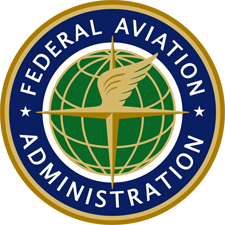
The Pilot Records Improvement Act (PRIA) requires all pilot employers operating under part 121, part 125, or part 135 to “request, receive, and evaluate certain information concerning pilot/applicant’s training, experience, qualification, and safety background, before allowing that individual to being service as a pilot with the company. The specific information they must check includes:
- FAA records, including your pilot and medical certificates
- Summaries of legal enforcement actions
- Air carrier records in the previous five years. This will include your performance in training, qualifications, check rides, and disciplinary actions.
- National Driver Register records
National Driver Register
The National Driver Register (NDR) is a computerized database containing information about drivers who have had revoked or suspended driver’s licenses. The NDR includes records of serious traffic violations.
If you are in the NDR you need to bring it an employer’s attention before their check is complete. Explain to them what you have learned from your experience and what you have done to rehabilitate your driving habits.
Putting it All Together
Before submitting your application and paperwork, run through a few checks:
- Proofread all documents and applications. Be meticulous about this.
- Include your name in the filename for your electronic resume and cover letter. Save it as ‘johnDoePilotResume.doc’ rather than ‘resume.doc’.
- Use a large envelop that will allow you to include documents without folding them.
- Do not send package via a method that requires special handling by the recipient, such as registered or return receipt required.
- Include all requested supporting documents and application fees.
- Before submitting your application make a copy of your file for your records.
- Keep your file active by updating your file or online application every 3 to 6 months or immediately if any significant changes occur to your qualifications, experience, or contact information, or according to company specific updating instructions.
- Be aware of the method you are using to send packages. Do not use express services unless there is a good reason for it. Also, do not send documents to UPS using Fedex or to Fedex using UPS.
- Companies with application windows usually only accept changes to your contact information when the window is closed.
- If a application window cycle is complete without any activity from the employer, submit a new application during the next window.
The Pilot Interview
You’ve earned your certificates and have spent countless hours in the air building experience. You’ve submitted your applications and now an employer wants to interview you. You have your foot in the door, but it is the pilot interview where you earn the job.
Pilot interviews are daunting. They include multiple phases with some of those phases involving panels of interviewers.
Interview Phases
Interview phases vary between employers. Pilot interviews include some combination of:
- Phone Interview
- Interview with Human Resources
- Flight Department Interview
- Oral Technical Evaluation
- Pilot Simulator Evaluation
- Written Exams
Telephone Interview
Pilot telephone interviews usually come unannounced and are used for pre-screening candidates. Telephone interviews are conducted by a recruiter and last around 15 minutes. The recruiter will run through the job description and requirements and verify information on your resume and application. There may be additional questions during this phase concerning your goals, background, why you are interested in that employer, and your employment availability.
Interview With Human Resources
This phase has two objectives:
- The screening interview seeks to verify or clarify previously submitted information such as applications, resumes, copies of licenses and medical certificates, and transcripts. The goal of company personal here is to make sure you are who you say you are. Most applicants pass this part.
- Human Resources personal will interview to determine an applicant’s corporate fit and if the pilot applicant is honest and credible. Interviewers will evaluate you based on appearance and temperament. Of candidates rejected during the interview phases, up to 70% will be rejected by human resources during this part of the interview.
Common Non-Technical Pilot Interview Questions
To be successful during the human resources phase of the interview an applicant will need to be prepared, enthusiastic, polite, and concise.
Flight Department Interview
The flight department interview is conducted by the chief pilot’s office, often times with the chief pilot present. This phase will focus on your flying qualifications. Be prepared to answer detailed questions about the airplane you currently fly.
This phase will focus on your ability to work as part of a team and other areas that relate to crew resource management (CRM). There will be at least one pilot present and they will be evaluating if they’d be willing to be with you for a multi-day trip.
Technical Evaluation
The technical evaluation is used to determine applicants technical skills in relation to their experience level. This phase can include a combination of various written exams as well as a verbal exam.
The verbal technical evaluation might be part of the flight department interview or conducted separately. This oral evaluation phase will test for technical knowledge and commonly cover subjects found in Airline Transport Pilot certification standards.
Some employers use an aptitude/intelligence test which includes testing for vocabulary, math, physics, regulations, aerodynamics, and weather. These tests have more questions than time to answer and are designed to not be completed.
Written personality exams can be part of the technical evaluation and are used to look for undesirable or desirable behavior patterns. The most commonly used test is the Minnesota Multiphasic Personality Inventory. The test has questions repeated in disguise throughout to test for consistency. Personality exams are long and don’t allow applicants to go back to change answers.
Pilot Simulator Evaluation
Simulator evaluations are used to assess an applicant’s basic instrument flying skills. Flight profiles used at an employer are consistent and don’t allow the use of autopilots or auto throttles. The level of flying skill of the applicant is expected to match their experience level.
The simulator evaluation often takes place on a different day from the other interview phases. However, this is part of the interview and applicants need to dress and act accordingly.
Get Tips and Tricks to Ace the Pilot Simulator Evaluation
Pilot Selection Process
The final selection is typically done by a board without the applicant present. The board has representatives from the flight department and human resources with all areas of applicant’s evaluation reviewed.
Pilot Interview Tips
Look Professional
Any job interview will judge a candidate on how they present themselves but this is especially so with pilot employers. Pilot employers look for candidates that will represent the company in a positive light and will put passengers as ease or relay instructions or updates to coworkers with authority.
The goal of a candidates appearance is to help recruiters and interviewers visualize them as a crew member with their company. Pilot job applicants need to be well dressed according to the common standards for pilot interviews and should be carefully groomed.
Speak Well
Applicants should use the interview to show interviewers that they can speak calmly and decisively and with strong English skills. Applicants should not use slang, idiomatic language, or bad language.
Research the Employer and Be Aware of Their Culture
Applicants need to be able to tailor answers to each employer. For example, if an employer is known for having a big personality an applicant would do well to emphasize outgoing aspects of their personality. If an employer is known for customer service then pilot applicants would want to make their answers customer-centric.
Think Global
Pilot employers are often wide spanning companies and are constantly influenced by external factors. Applicants should know about current affairs. Employers want someone with a passion for aviation, but they are also seeking a person who is well rounded and has an awareness of the world around them.
Research Common Interview Questions and Practice Answers for Them
Common interview questions can be found online. Applicants need to find the questions ahead of time and practice their answers. Most interview questions are open-ended and designed to have applicants answer in a narrative format. Yes or no answers are not appropriate.
Applicants need to be prepared to answer questions in an organized and controlled format with each answer being thought of as having an opening, middle, and close. Practice keeping answers concise and rarely longer than a minute or two.
Behavior
Applicants behavior is likely being monitored at all times while they are in contact with a potential employer. They should be on their best behavior when speaking with any person connected with the company. Applicants need to always speak honestly but should be guarded as to how much they share. Applicants must never assume they are safe from being observed or over heard.
Body Language
Body language sends a strong signal to interviewers. Good body language is important as it tells a lot about how an applicant feels about themselves. Body language needs to be consistent with words. Saying they are enthusiastic will not be communicated if an applicant says it meekly or while looking at their feet. Applicants should be aware of their posture and fidgeting and concentrate on making good eye contact, but without staring.
Greg started his professional pilot journey in 2002 after graduating from Embry Riddle. Since that time he has accumulated over 8,000 hours working as a pilot. Greg’s professional experience includes flight instructing, animal tracking, backcountry flying, forest firefighting, passenger charter, part 135 cargo, flying for a regional airline, a national low cost airline, a legacy airline, and also working as a manager in charge of Part 135 and Part 121 training programs.

